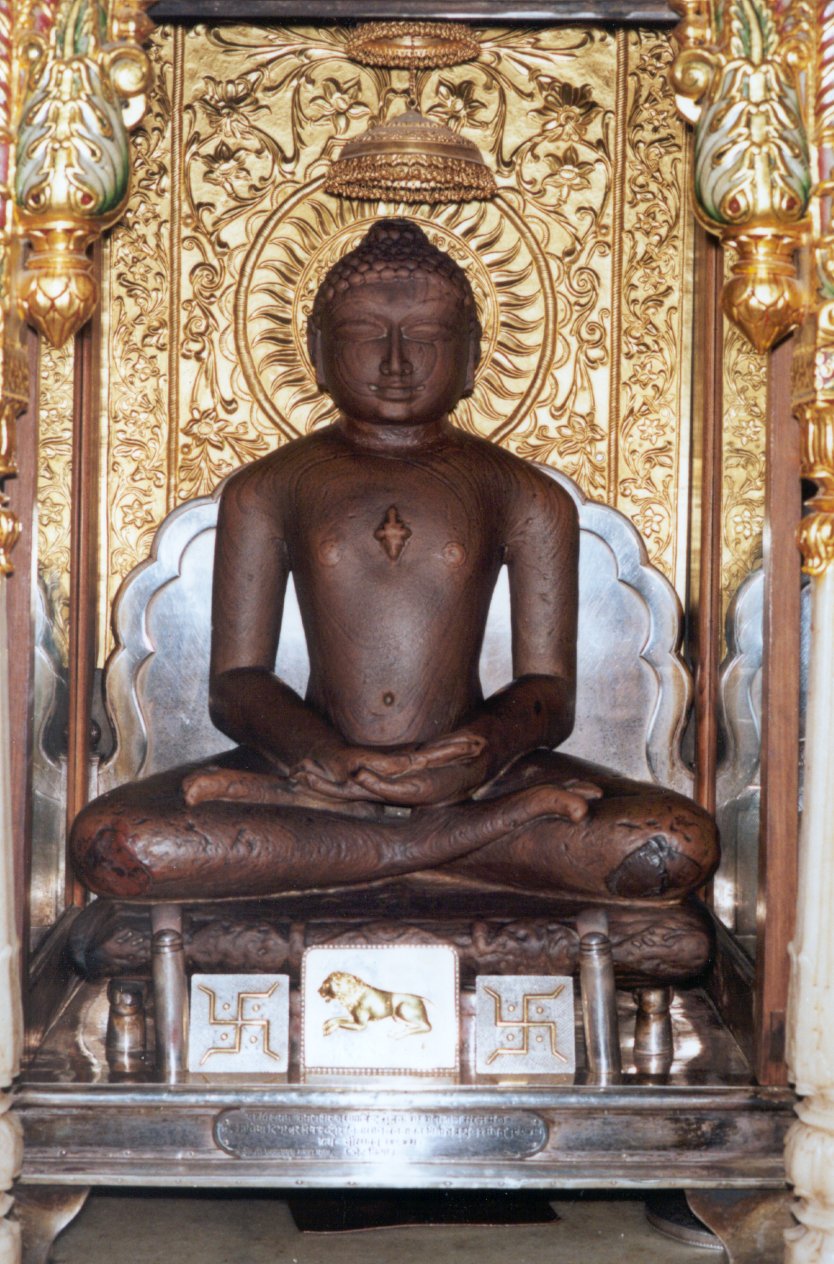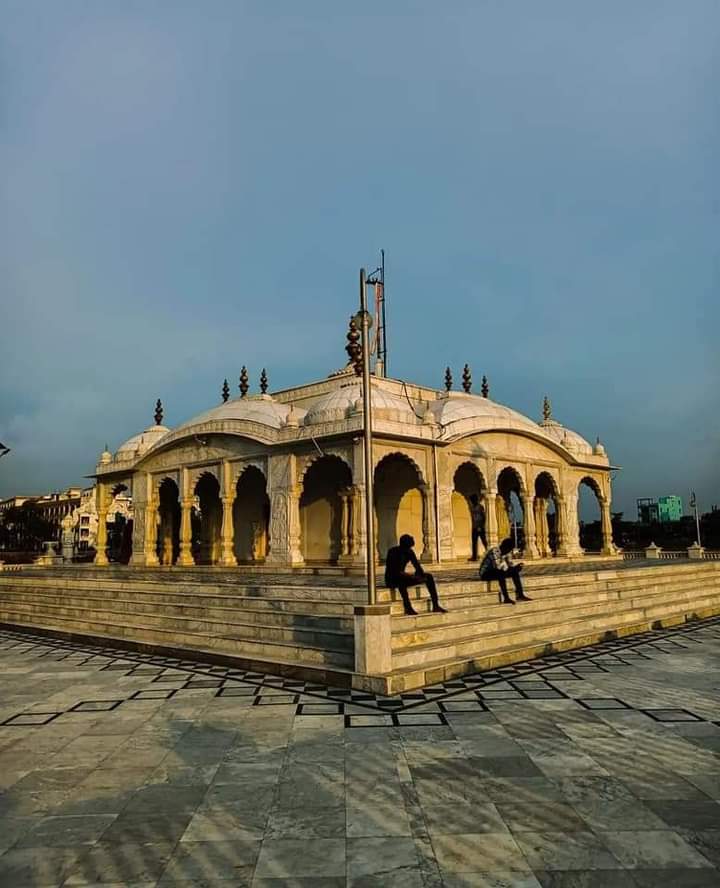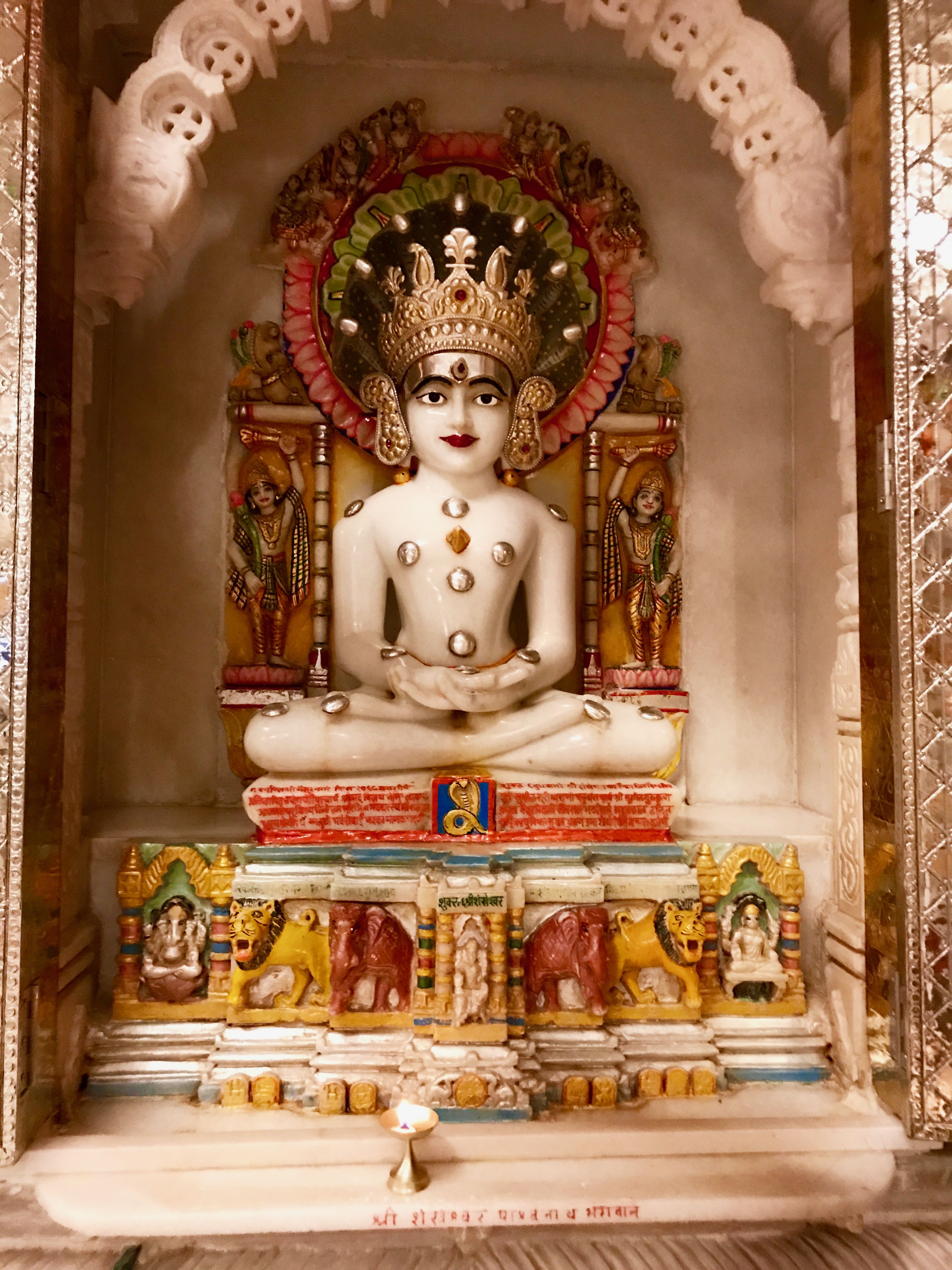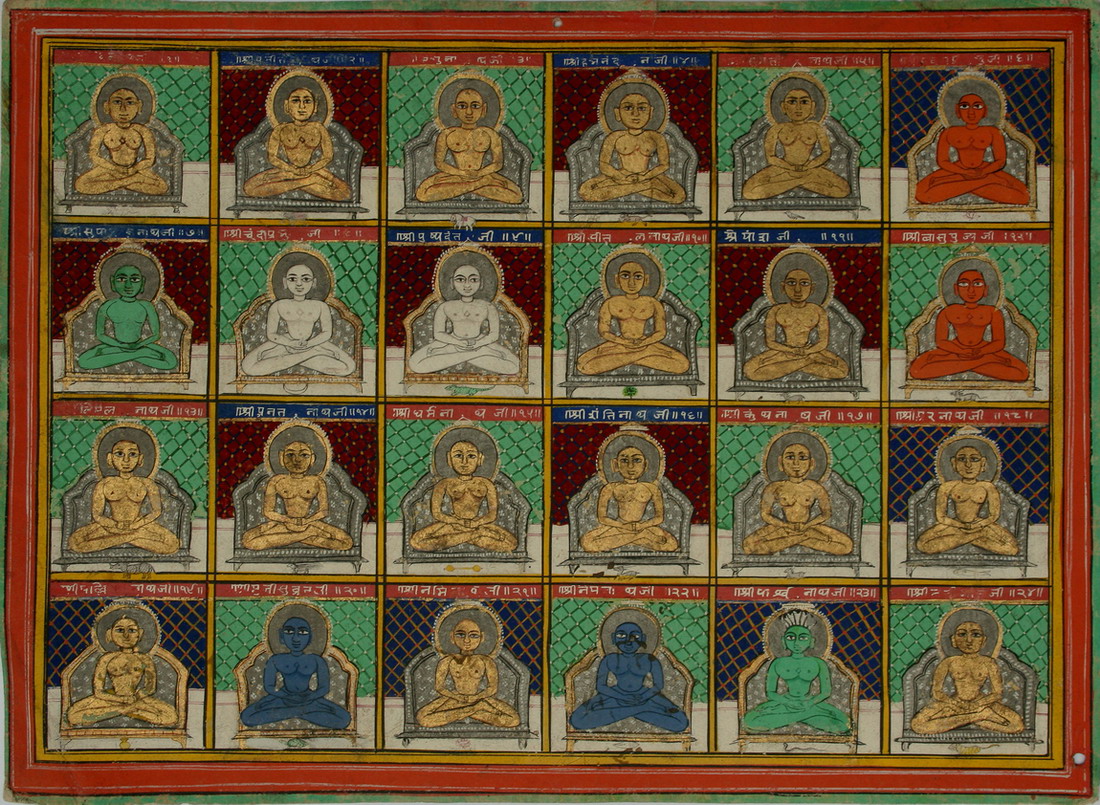|
Mahavir
Mahavira (Devanagari: महावीर, ), also known as Vardhamana (Devanagari: वर्धमान, ), was the 24th ''Tirthankara'' (Supreme Preacher and Ford Maker) of Jainism. Although the dates and most historical details of his life are uncertain and varies by Jain schools and branches, sect, historians generally consider that he lived during the 6th or 5th century BCE, reviving and reforming a proto-Jain community (which had possibly been founded by Pārśvanātha), and that he was an older contemporary of The Buddha, Gautama Buddha. Jains regard him as the spiritual successor of the 23rd ''Tirthankara'' Parshvanatha. According to traditional legends and hagiography, hagiographies, Mahavira was born in the early 6th century BCE to a royal Kshatriya Jain family of ancient India. His mother's name was Trishala and his father's name was Siddhartha of Kundagrama, Siddhartha. According to the second chapter of the Śvētāmbara Ācārāṅga Sūtra, Siddhartha and his f ... [...More Info...] [...Related Items...] OR: [Wikipedia] [Google] [Baidu] |
Shri Mahaveer Ji Temple
Shri Mahavir Ji is an important and prominent Jain pilgrimage site situated in Shri Mahaveer Ji (town), Shri Mahaveerji town in Hindaun Block, Karauli district in Rajasthan. Given the importance of the religious place, the Indian Railways has specifically developed a railway station under West Central Railway zone by the name of Shri Mahaveerji railway station which is 10 minutes drive from the temple and temple authorities have arranged for regular buses from the station to the temple. The temple is visited by millions of Jain and Hindu devotees every year. Main temple There are five temples in Shri Mahavirji. Atishaya Kshetra Shri Mahavirji is considered one of the miraculous pilgrimages of Jains. This pilgrimage is situated at banks of Gambhir River (Rajasthan), Gambhir river in Hindaun Block of Karauli district, Rajasthan. Built at the bank of a river, this pilgrimage is a prominent centre of devotion for Digambar Jain devotees. Chandanpur Mahavirji temple is hailed as ... [...More Info...] [...Related Items...] OR: [Wikipedia] [Google] [Baidu] |
Mahavira Janma Kalyanaka
Mahavira Janma Kalyanaka is one of the most important religious festivals in Jainism. It celebrates the birth of Mahavira, the twenty-fourth and last Tīrthaṅkara (supreme preacher) of present Avasarpiṇī. On the Gregorian calendar, the festivity occurs either in March or April. Birth According to Jain texts, Mahavira was born on the thirteenth day of the bright half of the moon in the month of '' Chaitra'' in the year 599 BC (Chaitra Sud 13). According to Shvetambara tradition, he was born in Kshatriyakund of Bihar. Some modern historians consider Kundagram (which is today's Kundalpur in Muzaffarpur district of Bihar) as his birthplace. He was born in a democratic kingdom (Ganarajya), Vajji, where the king was chosen by votes. Vaishali was its capital. He was named Vardhamana, meaning "One who grows", because of the increased prosperity in the kingdom at the time of his birth. In Vasokund, Mahavira is revered by the villagers. A place called ''Ahalya bhumi'' has ... [...More Info...] [...Related Items...] OR: [Wikipedia] [Google] [Baidu] |
Digambara
''Digambara'' (; "sky-clad") is one of the two major Jain schools and branches, schools of Jainism, the other being ''Śvetāmbara'' (white-clad). The Sanskrit word ''Digambara'' means "sky-clad", referring to their traditional monastic practice of neither possessing nor wearing any clothes. Nakedness was the ideal practice of lord Mahavira and his immediate followers. Mahavira emphasized the importance of nakedness for monks. It symbolizes complete detachment and is an ideal form of conduct. Mahavira believed that renouncing clothes made the body immune to external influences like heat and cold, increasing resilience. Without clothes, a monk would avoid the distractions of acquiring, maintaining, and washing garments, allowing him to focus on spiritual growth and self-discipline. Digambara and Śvetāmbara traditions have had historical differences ranging from their dress code, their temples and iconography, attitude towards female monastics, their legends, and the texts the ... [...More Info...] [...Related Items...] OR: [Wikipedia] [Google] [Baidu] |
Jainism
Jainism ( ), also known as Jain Dharma, is an Indian religions, Indian religion whose three main pillars are nonviolence (), asceticism (), and a rejection of all simplistic and one-sided views of truth and reality (). Jainism traces its spiritual ideas and history through the succession of twenty-four , supreme preachers of ''dharma''. The first in the current time cycle is Rishabhadeva, who tradition holds lived millions of years ago; the 23rd is Parshvanatha, traditionally dated to the 9th century Common Era, BCE; and the 24th is Mahāvīra, Mahavira, who lived . Jainism is considered an eternal ''dharma'' with the guiding every time cycle of the Jain cosmology, cosmology. Central to understanding Jain philosophy is the concept of ''bhedavijñāna'', or the clear distinction in the nature of the soul and non-soul entities. This principle underscores the innate purity and potential for liberation within every Jīva (Jainism), soul, distinct from the physical and menta ... [...More Info...] [...Related Items...] OR: [Wikipedia] [Google] [Baidu] |
Diwali (Jainism)
Diwali in Jainism marks the anniversary of '' Nirvana'' (final release) or liberation of Mahavira's soul, the twenty-fourth and last Jain Tirthankara of the present cosmic age. It is celebrated at the same time as the Hindu festival of Diwali. Diwali marks the end of the year for Jains, and it likewise commemorates the passing of their twenty-fourth Tirthankara Mahavira and his achievement of moksha. History According to ''Tilyapannatti'' of Yativrsabha, Mahavira attained Moksha (liberation) on this day at Pawapuri on 15 October 527 BCE, on Chaturdashi of Kartika. Mahavira, the 24th ''Tirthankara'' of this era, revitalised Jain dharma. According to tradition, the chief disciple of Mahavira, '' Ganadhara'' Gautam Swami also attained omniscience i.e. absolute or complete knowledge ('' Kevala Jñāna'') on this day, thus making Diwali one of the most important Jain festivals. Mahavira attained his nirvana at the dawn of the amavasya (new moon). According to the ''Śv ... [...More Info...] [...Related Items...] OR: [Wikipedia] [Google] [Baidu] |
Jain Temple, Kundalpur (Bihar)
Jain temple, Kundalpur is a complex of six Jain Jain temple, temples located in Kundalpur, Bihar, Kundalpur village near Nalanda, Bihar. Kundalpur is one of the most important Jain pilgrimages in Bihar. History Kundalpur was an ancient capital city ruled by the Licchavi (tribe), Licchavi. Kundalpur is believed to be the birthplace of Mahavira, the 24th ''tirthankara'' of Jainism. This place is also believed to birthplace of four of the eleven ''Ganadhara'' of Mahavira, including Gautama Swami. Architecture The ancient Jain temple called ''Simhamukhi Teela'' is located near Nalanda and houses a idol of Mahavira. The temple houses a number of Jain artifacts. The new temple complex, located from the ancient temple, consists of five temples. The temple is constructed using stones from Jaisalmer housing idols of Mahavira, Rishabhanatha and Gautama Swami. In Kundalpur temple complex, a total of 72 idols of Tirthankaras are installed in a separate temples. The temple also has a ... [...More Info...] [...Related Items...] OR: [Wikipedia] [Google] [Baidu] |
Pawapuri
Pawapuri, or Pavapuri (also called Apapapuri, meaning "the sinless town"), is a holy site for Jainism, Jains located in the Nalanda district of Bihar state in East India, eastern India. It is located about 19 kilometres from Rajgir and 101 kilometres from Patna, the capital of Bihar. Pawapuri is Mahavira's ''nirvana'' and a pilgrimage site for Jains. Tourism Pawapuri in Nalanda district ranks second after Rajgir in Nalanda in terms of tourism. Among the main tourist attractions, the Jal Mandir here is world-famous. It is believed that Lord Mahavira (the 24th 24th Tirthankara, Tirthankara of Jainism) was cremated at this place after attaining Mahanirvana. Most of the tourists come to Pawapuri in thousands to see the beauty of the water temple. Spread over an area of 84 bighas, the beauty of the pond of this Jal Mandir has a different importance. In the summer, lotus flowers enhance the beauty of this pond, due to which this pond is also known as Kamal Sarovar. And during ... [...More Info...] [...Related Items...] OR: [Wikipedia] [Google] [Baidu] |
Śvetāmbara
The Śvetāmbara (; also spelled Shwetambara, Shvetambara, Svetambara or Swetambara) is one of the two main branches of Jainism, the other being the Digambara. ''Śvetāmbara'' in Sanskrit means "white-clad", and refers to its ascetics' practice of wearing white clothes, which sets it apart from the ''Digambara'' or "sky-clad" Jains whose ascetic practitioners go nude. Śvetāmbaras do not believe that ascetics must practice nudity. The Śvetāmbara and Digambara traditions have had historical differences ranging from their dress code, their temples and iconography, attitude towards Jain nuns, their legends and the texts they consider as important. Śvetāmbara Jain communities are currently found mainly in Gujarat, Rajasthan and coastal regions of Maharashtra. According to Jeffery D. Long, a scholar of Hindu and Jain studies, about four-fifths of all Jains in India are Śvetāmbaras. History and lineage Śvetāmbaras consider themselves to be the original followers of Maha ... [...More Info...] [...Related Items...] OR: [Wikipedia] [Google] [Baidu] |
Mahavira (other)
Mahavira may refer to: * Mahavira Mahavira (Devanagari: महावीर, ), also known as Vardhamana (Devanagari: वर्धमान, ), was the 24th ''Tirthankara'' (Supreme Preacher and Ford Maker) of Jainism. Although the dates and most historical details of his lif ... (599–527 BCE), 24th and last Jain Tirthankara (enlightened reformer) in the current avsarpini (cosmological cycle of Jainism); a contemporary of the Buddha and considered to be the historical founder of Jainism * Another name for Hanuman, Hindu god, devotee of Rama in the Indian epic ''Ramayana'' * Mahāvīra (mathematician), 9th-century Indian Jain mathematician * Mahavira Hall, main hall of a Buddhist temple in China, Korea and Vietnam * ''Mahaveera'' (film), 1988 Indian film * '' Mahavira: The Hero of Nonviolence'', a book about the founder of Jainism * Shri Mahaveer Ji (town), a town and pilgrimage centre in Rajasthan, India ** Shri Mahaveer Ji temple, a Mahavira Jain temple in the town ... [...More Info...] [...Related Items...] OR: [Wikipedia] [Google] [Baidu] |
Siddhartha Of Kundagrama
Siddhartha was the father of Mahavira (Vardhamana), the 24th Jain Tirthankara. He was a Kshatriya ruler from the Ikshvaku dynasty and the Gaṇa Mukhya of the Nāya clan in Kundagrama, a suburb of Vaishali. He was married to Licchavi princess Trishala (sister of Chetaka of Vaishali). The parents of Tirthankaras and their mothers in particular are worshipped among Jains and are frequently depicted in paintings and sculpture. According to the second chapter of the Śvētāmbara Ācārāṅga Sūtra, Siddhartha and his family were devotees of Parshvanatha.After his death, Nandivardhana became the gaṇa mukhya of the Nāya Republic. Siddhartha and Trishala died by observing '' Santhara'' (fast unto death) when Vardhamana was 28 years of age. Following his parents' demise, Vardhamana decided to take permission from his uncle Suparshva and elder brother Nandivardhana, who dissuaded him from renouncing worldly life for two more years because he was unable to bear the l ... [...More Info...] [...Related Items...] OR: [Wikipedia] [Google] [Baidu] |
Pārśvanātha
''Pārśvanātha'' (), or and ''Pārasanātha'', was the 23rd of 24 ''Tirthankara, tīrthaṅkaras'' ("Ford-Maker" or supreme preacher of Dharma (Jainism), Dharma) of Jainism. According to traditional accounts, he was born to King Aśvasena and Queen Vāmādevī of the Ikshvaku dynasty in the north west Indian city of Benaras , Varanasi in 9th century BCE. Pārśvanātha is the earliest Jaina ''tīrthaṅkaras'' who is acknowledged as possibly a historical figure: with some teachings attributed to him that may be accurately recorded, and a possible historical nucleus within the legendary accounts of his life from traditional hagiographies. Historians consider that he may actually have lived between 8th to 6th century BCE, founding a proto-Jaina Śramaṇa, ascetic community which subsequently got revived and reformed by Mahavira, Mahāvīra (6th or 5th century BCE). According to traditional Jaina sources, Pārśvanātha was born 273 years before Mahavira, Mahāvīra, which pl ... [...More Info...] [...Related Items...] OR: [Wikipedia] [Google] [Baidu] |
Tirthankara
In Jainism, a ''Tirthankara'' (; ) is a saviour and supreme preacher of the ''Dharma (Jainism), dharma'' (righteous path). The word ''tirthankara'' signifies the founder of a ''Tirtha (Jainism), tirtha'', a fordable passage across ''Saṃsāra (Jainism), saṃsāra'', the sea of interminable birth and death. According to Jains, ''tirthankaras'' are the supreme preachers of ''dharma'', who have conquered ''saṃsāra'' on their own and made a path for others to follow. After understanding the true nature of the self or soul, the ''Tīrthaṅkara'' attains ''kevala jnana'' (omniscience). A Tirthankara provides a bridge for others to follow them from ''saṃsāra'' to ''moksha'' (liberation). In Jain cosmology, the wheel of time is divided into two halves, Utsarpiṇī', the ascending time cycle, and ''avasarpiṇī'', the descending time cycle (said to be current now). In each half of the cycle, exactly 24 ''tirthankaras'' grace this part of the universe. There have been infini ... [...More Info...] [...Related Items...] OR: [Wikipedia] [Google] [Baidu] |








